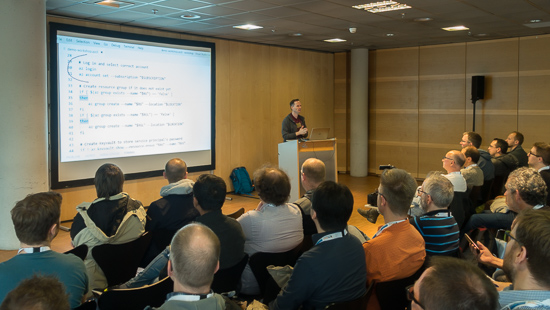Building a Tiny Docker Image
28 April 2019 - Docker, Container, Assembler
Introduction
Tomorrow, I will do a session at a high school for computer science. They asked me to speak about Docker container and related technologies like Kubernetes. In the session, I want to highlight that containers are not just VMs. So I decided to build a tiny, tiny Docker image using assembler language.
Image with NASM
We will use the Netwide Assembler NASM to build the executable for our tiny container. Let’s build an Alpine-based image and install NASM in it. Here is a Dockerfile for that:
FROM i386/debian
LABEL author="Rainer Stropek @rstropek"
# Install packages necessary for installing NASM
RUN apt-get update \
&& apt-get install -y \
asciidoc \
build-essential \
curl \
xmlto
# Default version of NASM that we want to install
ARG NASMVERSION=2.14.02
# Download and install NASM
RUN curl --output nasm-${NASMVERSION}.tar.gz -L https://www.nasm.us/pub/nasm/releasebuilds/${NASMVERSION}/nasm-${NASMVERSION}.tar.gz \
&& tar -xzf nasm-${NASMVERSION}.tar.gz --directory /usr/local/src \
&& cd /usr/local/src/nasm-${NASMVERSION}/ \
&& ./configure \
&& make \
&& make install
# Run shell if container is started
CMD ["/bin/bash"]
Build the Docker image with docker build -t rstropek/nasm-gcc . (replace rstropek with your Docker Hub user).
Assembler Hello World
Next, let’s write an assembler program with some Linux Kernel calls. I call it hello.asm.
BITS 32
SECTION .data ; DATA
msg: db "Hello World",10 ; This is the text we want to print.
; The 10 at the end means "next line" (see
; http://www.asciitable.com/)
len: equ $-msg ; We calculate the length of the text by
; subtracting the memory address of msg
; from the current address ("$")
SECTION .text ; PROGRAM CODE
global _start ; Program starts at _start
_start:
; We use the Linux syscall "write"
; (see http://man7.org/linux/man-pages/man2/write.2.html)
mov edx, len ; edx receives the length of the string
; edx is a so called "register" (Details see
; https://en.wikipedia.org/wiki/Processor_register)
mov ecx, msg ; ecx receives the address of the text
mov ebx, 1 ; 1 means "stdout" = screen
mov eax, 4 ; 4 identifies the syscall "write"
int 0x80 ; Call Linux kernel with interrupt 0x80
; To exit, we use the syscall "exit"
; (see http://man7.org/linux/man-pages/man2/exit.2.html)
mov ebx, 0 ; 0 means "no error"
mov eax, 1 ; 1 identifies the syscall "exit"
int 0x80
Generate Tiny Image
Now we can use our previously created image rstropek/nasm-gcc with NASM to generate our tiny image in a multi-staged build process:
# Use a multi-stage build
FROM rstropek/nasm-gcc AS build
# Arguments for gcc:
# - Compile for 32bit
# - Link statically
# - Optimize for size
# - No standard system startup file (we have our own _start)
# - No unwind tables (to make our executable even smaller)
ARG GCCARGS="-m32 -static -Os -nostartfiles -fno-asynchronous-unwind-tables"
WORKDIR /src
COPY hello.asm /src
# Compile and link our assembler code
RUN nasm -f elf hello.asm \
&& gcc ${GCCARGS} -o hello hello.o \
&& strip -R .comment -s hello
FROM scratch
COPY --from=build /src/hello /
CMD ["/hello"]
Build the Docker image with docker build -t rstropek/hello-world . (replace rstropek with your Docker Hub user).
Let’s Check the Size
rainer@dockervm:~/containerdata/nasm$ docker images rstropek/hello-world
REPOSITORY TAG IMAGE ID CREATED SIZE
rstropek/hello-world latest 53fc14858574 8 minutes ago 484B
484 Bytes, nice. Does it work?
rainer@dockervm:~/containerdata/nasm$ docker run rstropek/hello-world
Hello World
Yes it does :-)




